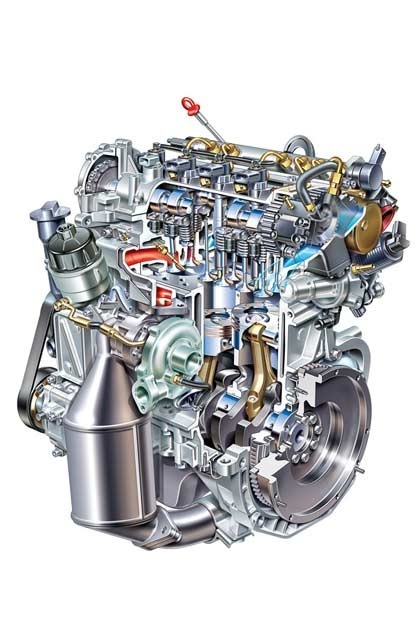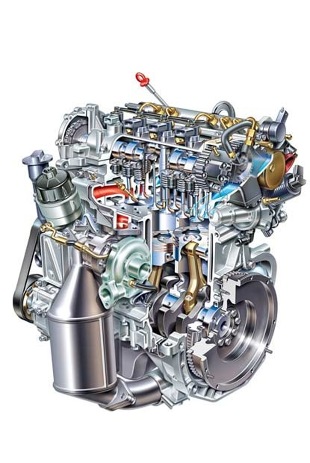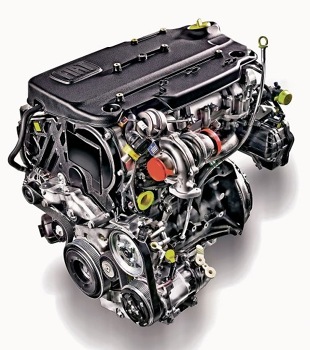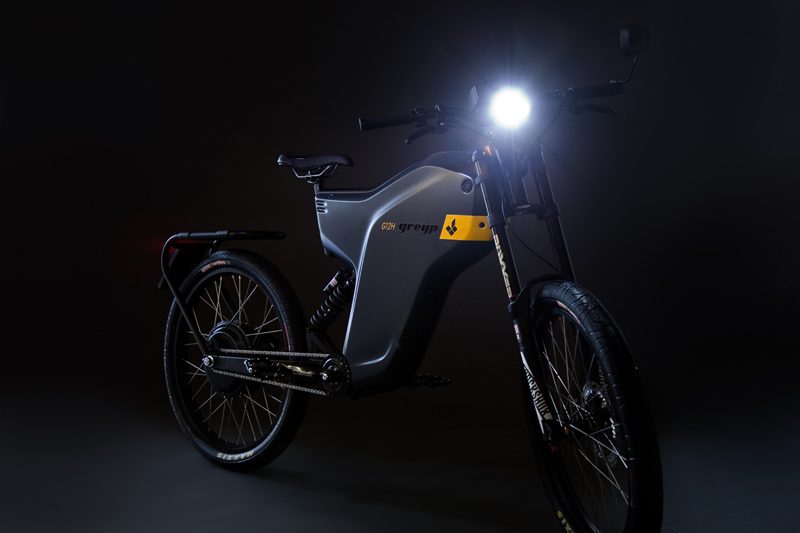
Are JTD motors fail safe? Market overview and work
Content
 JTD is an abbreviation for uniJet Turbo Diesel, i.e. designations of diesel engines installed on cars of the Fiat group.
JTD is an abbreviation for uniJet Turbo Diesel, i.e. designations of diesel engines installed on cars of the Fiat group.
The Italians are considered the forerunners of the direct injection system, despite the fact that some components were supplied by German manufacturers. In terms of more than 25 years, it is safe to say that Fiat's contribution to the global development of diesel engines has been enormous. It was the Italian manufacturer in the 80s that introduced the first diesel engine with direct fuel injection, which was installed on the Croma model.
Market competitors were not indifferent and improved their technologies from year to year, and in the meantime, Fiat took another step forward and introduced the world's first car with a common rail diesel engine under the hood. It was a real breakthrough moment. The only thing that raised doubts was the durability of the innovative design and engine units.
JTD engines. Drive versions
The smallest JTD engine had a volume of 1.3 liters, it was its basic version (made in Poland), which in 2005 received a special award, more precisely the prestigious title of "International Engine of the Year" in the category of units up to 1.4 liters. The awarded engine was available in two power options: 70 hp. and 90 hp in: Fiat 500, Grande Punto, Opel Astra, Meriva, Corsa or Suzuki Swift.
Since 2008, the manufacturer has also offered a 1.6-liter version with 90 hp, 105 hp. and 120 hp respectively. The most powerful, it had a factory DPF filter, which allowed it to meet the Euro 5 emission standard. It could be ordered, among others, for the Fiat Bravo, Grande Punto, Lancia Delta or Alfa Romeo MiTo. The iconic 1.9 JTD made its debut in the Alfa Romeo 156. The eight-valve 1.9 JTD UniJet ranged from 80 to 115 hp, the MultiJet from 100 to 130 hp, and the six-valve MultiJet from 136 to 190 hp. It has appeared in many Alfa Romeo, Fiat, Lancia, Opel, Saab and Suzuki models.
The 2.0 MultiJet engine was also available on the market, and this is nothing but a design development of the 1.9 MultiJet with 150 hp. The working volume increased by 46 cubic meters. cm by increasing the diameter of the cylinders from 82 to 83 mm. In the modernized engine, the compression ratio was reduced, which had a positive effect on reducing nitrogen oxide emissions. In addition, the unit received a particulate filter and an EGR exhaust gas recirculation system. The 2.0 MultiJet was available in some Fiat and Lancia in a 140 hp variant, and in Alfa Romeo where it was rated at 170 hp.
See also: Skoda Octavia vs. Toyota Corolla. Duel in segment C
Over time, the concern prepared a completely new design JTD with a volume of 2.2 liters in two power options - 170 hp. and 210 hp, designed for Maserati and Alfa Romeo sports cars, and more specifically the Ghibli, Levane, Stelvio and Giulia models. . The Italian range also includes a 5-cylinder version with a volume of 2.4 liters, as well as 2.8 and 3.0 engines. The largest of them was dedicated to cars such as the Maserati Ghibli and Levante, as well as the Jeep Grand Cherokee and Wrangler.
JTD engines. Operation and malfunctions
The Italian JTD and JTDM engines are undoubtedly successful developments, which may come as a surprise to some. Serious breakdowns are rare, minor breakdowns do happen, but this is due to high mileage, improper or too heavy use, or inadequate maintenance, which is still easy to find.
- 1.3 MultiJet
 The basic version (first generation) installed on Fiats has a turbocharger with a fixed blade geometry, a more powerful one has a variable geometry turbine. The undoubted advantage of this small motor is the gas distribution system, which is based on a chain and a strong single-mass clutch. With a run of about 150 - 200 thousand. km, there may be a problem with the EGR valve.
The basic version (first generation) installed on Fiats has a turbocharger with a fixed blade geometry, a more powerful one has a variable geometry turbine. The undoubted advantage of this small motor is the gas distribution system, which is based on a chain and a strong single-mass clutch. With a run of about 150 - 200 thousand. km, there may be a problem with the EGR valve.
When buying a used car, you should pay attention to the oil pan, which is located very low, which makes it especially vulnerable to damage. There are two versions of this power unit on the market: with a diesel particulate filter that complies with Euro 5 emission standards and without a diesel particulate filter that complies with Euro 4.
Most often, filters are found in cars imported from abroad, where the Euro 5 standard has been in force since 2008, and in Poland it appeared only in 2010. Meanwhile, in 2009, the second generation 1.3 Multijet was launched with a factory-installed particulate filter. This is a solid construction that, with proper maintenance, can travel 200-250 thousand kilometers. miles without any problems.
- 1.6 MultiJet
 The engine appeared in 2008 and belongs to the 1.9 JTD. The basis of the motor is a cast-iron block with two camshafts driven by a belt. In this design, engineers have focused on improving performance, reducing fuel consumption and reducing vehicle exhaust emissions. The 1.6 MultiJet has four cylinders, a second generation Common Rail system and a relatively simple design.
The engine appeared in 2008 and belongs to the 1.9 JTD. The basis of the motor is a cast-iron block with two camshafts driven by a belt. In this design, engineers have focused on improving performance, reducing fuel consumption and reducing vehicle exhaust emissions. The 1.6 MultiJet has four cylinders, a second generation Common Rail system and a relatively simple design.
The turbocharger with fixed blade geometry can be found in 90 and 105 hp versions. The weakest variety does not have a particulate filter. In this engine, Fiat applied one of the most interesting solutions, namely the DPF filter was installed immediately after the compressor, which had a positive effect on reaching the maximum soot burning temperature - which makes the filter practically maintenance-free.
- 1.9 JTD Unijet
 We can safely say that this is the flagship motor of the Italian manufacturer. The period of its production fell on 1997 - 2002. The eight-valve design was available in several power options, the engines differed in the type of equipment used, including. intake manifolds, injectors and turbos.
We can safely say that this is the flagship motor of the Italian manufacturer. The period of its production fell on 1997 - 2002. The eight-valve design was available in several power options, the engines differed in the type of equipment used, including. intake manifolds, injectors and turbos.
80 hp version had a turbocharger with a fixed geometry of the blades, the rest - with a variable geometry. The solenoid injection system was supplied by Bosch and can be repaired relatively cheaply in the event of a malfunction. The flow meter and thermostat, as well as the EGR, can be emergency (clogged). At much higher mileage, it may collide with the dual mass flywheel, if this happens, it can be replaced with a single mass flywheel.
- 1.9 8В / 16В MultiJet
The successor appeared in 2002 and, unlike its predecessor, differed mainly in the use of Common Rail II injection. Experts mainly recommend 8-valve options. In this case, the nozzles were also supplied by the German company Bosch. The most common on the market is the 120-horsepower version. The manufacturer's offering also included a 1.9-litre twin-supercharged engine. It is a very advanced design and expensive to repair. In 2009, a new generation of Multijet 2 engines was introduced.
- 2.0 MultiJet II
 The new design was based on that of a slightly smaller brother. The motor has undergone a number of modifications that have allowed it to comply with the strict Euro 5 emission standards. The unit works as standard with a DPF filter and an electrically controlled EGR valve. The common rail injection system (also supplied by Bosch) creates a pressure of 2000 bar, the hydraulic valve accurately doses the amount of fuel, which reduces fuel consumption and improves engine performance. Installation users report problems with high oil consumption, the DPF filter and the EGR valve, which is electronic and more expensive to replace. In this case, you can also find a biturbo version, which can be expensive and very difficult to repair.
The new design was based on that of a slightly smaller brother. The motor has undergone a number of modifications that have allowed it to comply with the strict Euro 5 emission standards. The unit works as standard with a DPF filter and an electrically controlled EGR valve. The common rail injection system (also supplied by Bosch) creates a pressure of 2000 bar, the hydraulic valve accurately doses the amount of fuel, which reduces fuel consumption and improves engine performance. Installation users report problems with high oil consumption, the DPF filter and the EGR valve, which is electronic and more expensive to replace. In this case, you can also find a biturbo version, which can be expensive and very difficult to repair.
- 2.2 JTD
 According to some theories, the engine was created for the needs of the middle class vans offered by Fiat and Lancia. Technologically, this is the PSA structure - with the Common Rail system. In 2006, engineers made significant changes and increased power. Experts pay attention to recurring injector malfunctions (fortunately, they can be regenerated), as well as dual-mass wheels and a particulate filter.
According to some theories, the engine was created for the needs of the middle class vans offered by Fiat and Lancia. Technologically, this is the PSA structure - with the Common Rail system. In 2006, engineers made significant changes and increased power. Experts pay attention to recurring injector malfunctions (fortunately, they can be regenerated), as well as dual-mass wheels and a particulate filter.
- 2.4 20 V MultiJet 175/180 km
The motor debuted in 2003, had a 20-valve cylinder head and second-generation MultiJet direct injection, as well as a variable geometry turbocharger and a DPF filter. The undoubted advantage of the design is excellent dynamics, reasonable combustion and work culture. Parts are quite expensive, the problem may be in the DPF filter and the EGR valve.
It should be remembered that this is an advanced design, so repair costs are not low. The earlier 10-valve version, produced between 1997 and 2002, was more durable, had simpler parts, and therefore had a longer life and, importantly, cheaper maintenance.
- 2.8 MultiJet
This is a product of VM Motori, an Italian manufacturer of diesel units based on common rail technology and piezoelectric injectors with a pressure of 1800 bar. The disadvantage of this design is the problematic DPF filter. Especially when driving in the city, a significant amount of soot accumulates, which in turn reduces engine power and leads to costly repairs. Despite this, the unit has a reputation for being permanent.
- 3.0 V6 MultiJet
This design was also developed by VM Motori, equipped with a variable geometry turbocharger from the renowned Garret company and a MultiJet II power system. The unit is viable, users emphasize that basic maintenance (with simultaneous) oil changes should be done more often than specified by the manufacturer.
JTD engines. Which unit would be the best choice?
As you can see, there are many varieties of the JTD and JTDM families, the engines are good, but if we talk about the leader, then we choose version 1.9 JTD. Mechanics and users themselves praise this unit for efficiency and acceptable fuel consumption. There is no shortage of spare parts on the market, they are available almost immediately and often at a reasonable price. For example, a complete timing gear with a water pump costs about PLN 300, a clutch kit with a dual-mass wheel for a 105 hp version. In addition, the base 1300 JTD is resistant to low-quality fuel, which, unfortunately, negatively affects the culture of its work, but something for something.
Skoda. Presentation of the line of SUVs: Kodiaq, Kamiq and Karoq
